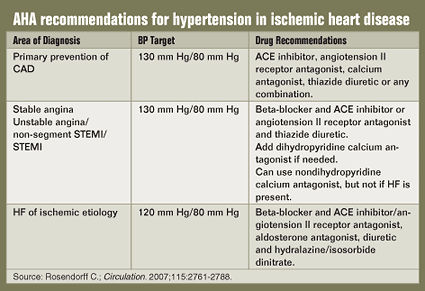AHA issues statement about hypertension in patients with ischemic heart disease
Information on treating hypertension in this population was previously limited.
The best choices for a target hypertension level and antihypertensive treatment for the prevention and management of ischemic heart disease remain controversial.
An American Heart Association scientific statement, published in Circulation, on the treatment of hypertension in people with ischemic heart disease details recommendations for systolic and diastolic BP targets and effective antihypertensive agents in the primary and secondary prevention and treatment of this condition.
Clive Rosendorff, MD, PhD, professor of medicine at Mt. Sinai School of Medicine, summarized these recommendations at the American Society of Hypertension 22nd Annual Scientific Meeting.
Prevention
The AHA’s Council for High BP Research and the Councils on Clinical Cardiology and Epidemiology and Prevention established a series of recommendations for treating hypertension in patients with established CAD with stable angina, patients with unstable angina and non-segment STEMI, unstable angina and STEMI or patients with HF of ischemic origin.
“When trying to establish recommendations, two questions were asked: ‘What are the appropriate BP targets for each category? Which antihypertensive drug should be used in each category?’” Rosendorff said.
It was determined that all patients should maintain a BP level of 130 mm Hg/80 mm Hg, and patients with HF of ischemic etiology should be considered for a BP level of 120 mm Hg/80 mm Hg.
“We hope that when people think of the numbers 130 mm Hg/80 mm Hg as the target for diabetes, they will now also include CAD — both established CAD and for patients at high risk,” Rosendorff said.

CAD and stable angina
Rosendorff spoke specifically about the recommendations for management of hypertension in patients with CAD and stable angina.
“If the patient has stable angina, beta-blockers, ACE inhibitors or [angiotension II receptor antagonists] or thiazide diuretics are the keystones of treatment,” he said. “You can use all of them together or individually. Beta-blockers are particularly effective for symptom relief. If there is a prior history of MI, diabetes or left ventricular systolic dysfunction, an ACE inhibitor should be used.”
If patients are prescribed these treatments and angina or hypertension persists, a long-acting dihydropyridine calcium antagonist can be added to any of these treatments, according to Rosendorff. If beta-blockers are contraindicated, a nondihydropyridine calcium antagonist, like diltiazem or verapamil, can be added to the beta-blocker with caution due to risk for bradyarrhythmias or HF.
The complete list of recommendations for BP reduction and the management of CAD and its various manifestations are available online in Circulation. – by Leah Lawrence
For more information:
- Rosendorff C. AHA perspective/hypertension management and blood pressure goals. Presented at: the American Society of Hypertension 22nd Annual Meeting; May 19-22; Chicago.
- Rosendorff C, Black HR, Cannon CP, et al. Treatment of hypertension in the prevention and management of ischemic heart disease: A scientific statement from the America Heart Association Council for High Blood Pressure Research and the Councils on Clinical Cardiology and Epidemiology and Prevention. Circulation. 2007;115:2761-2788.
